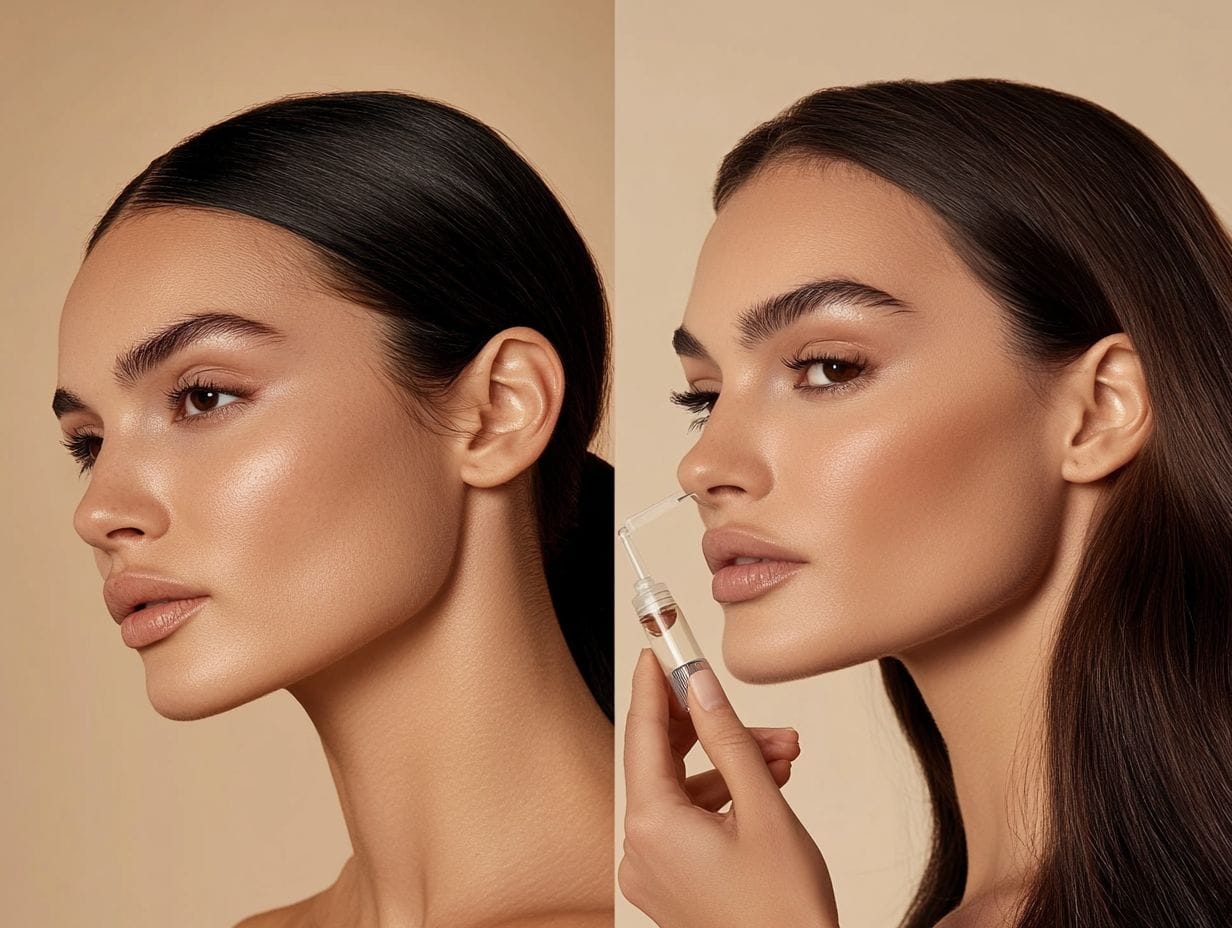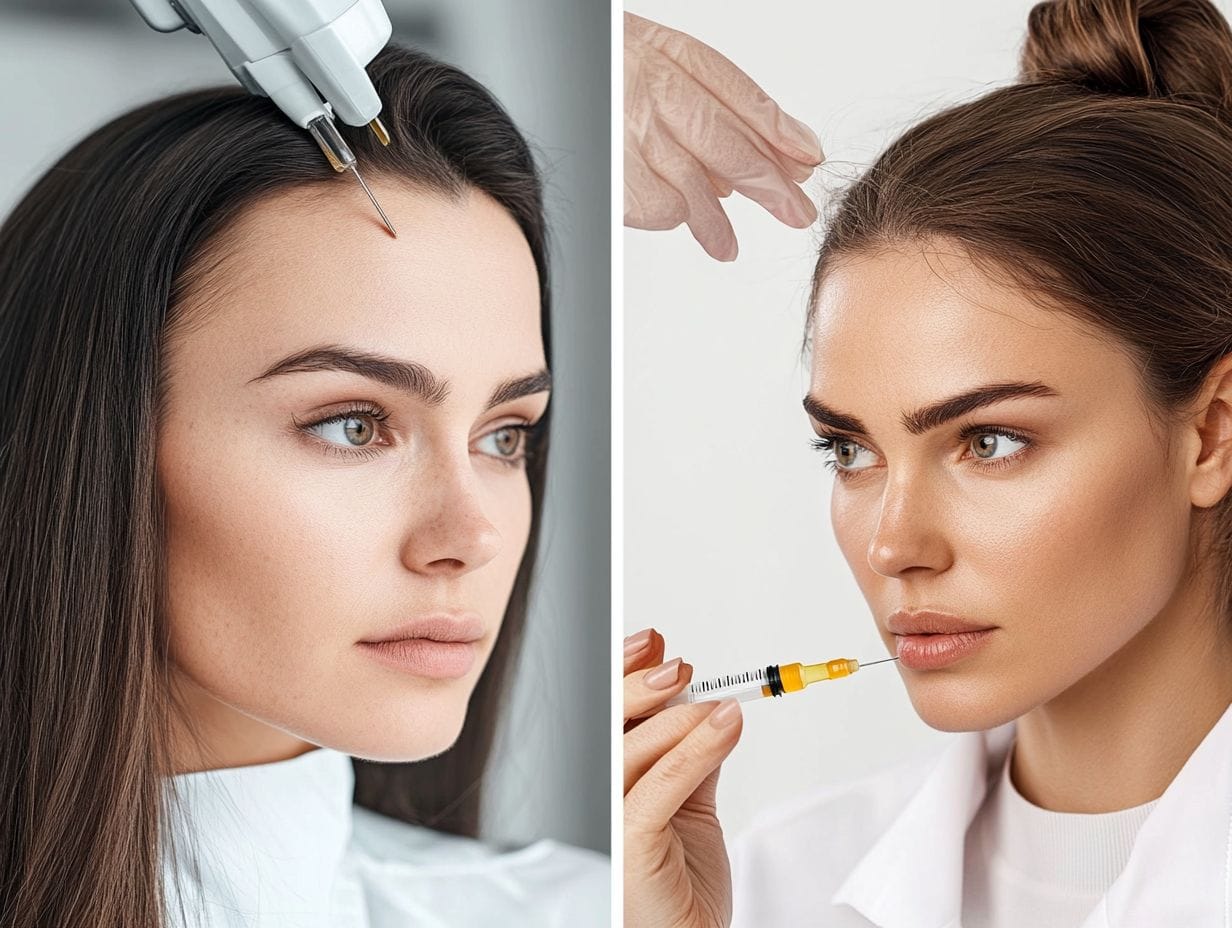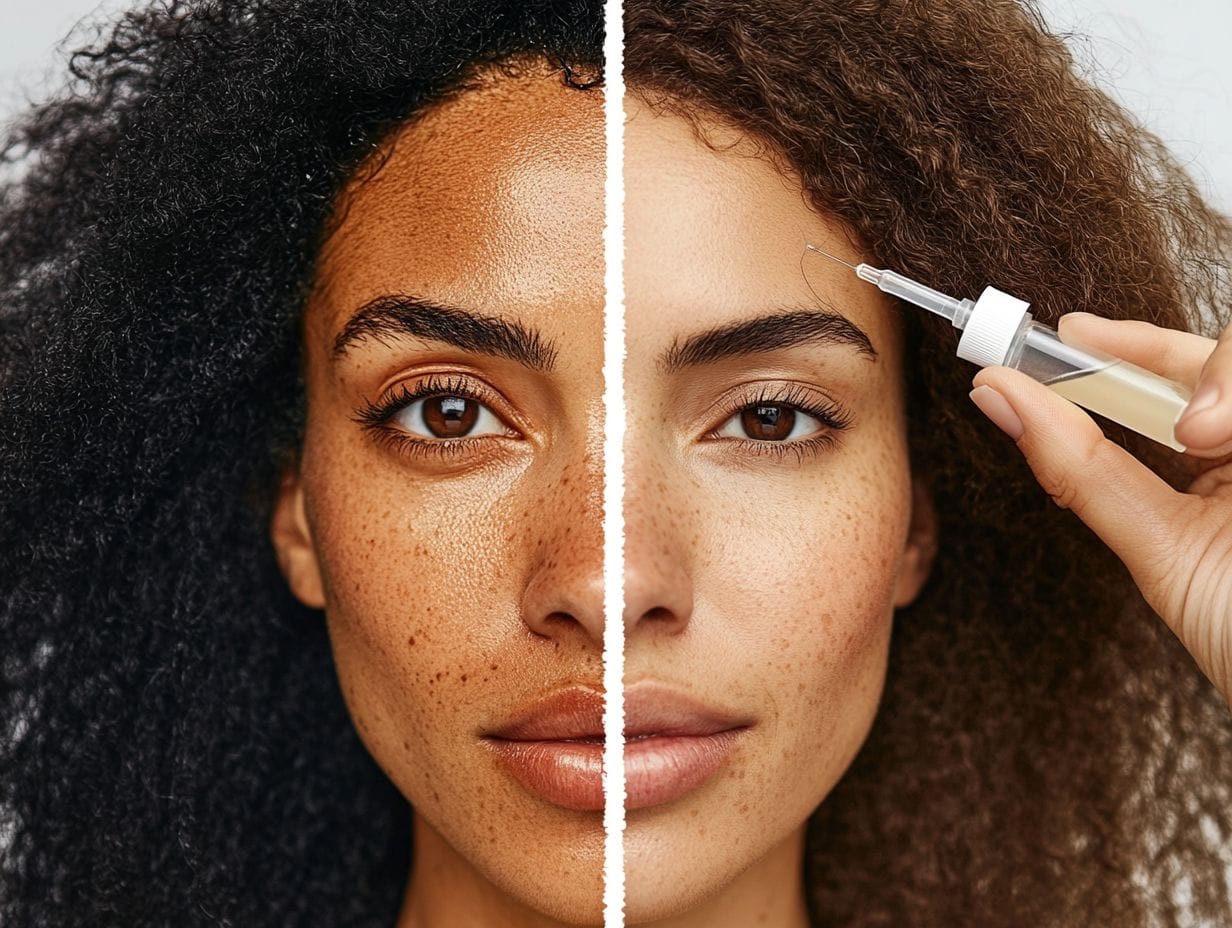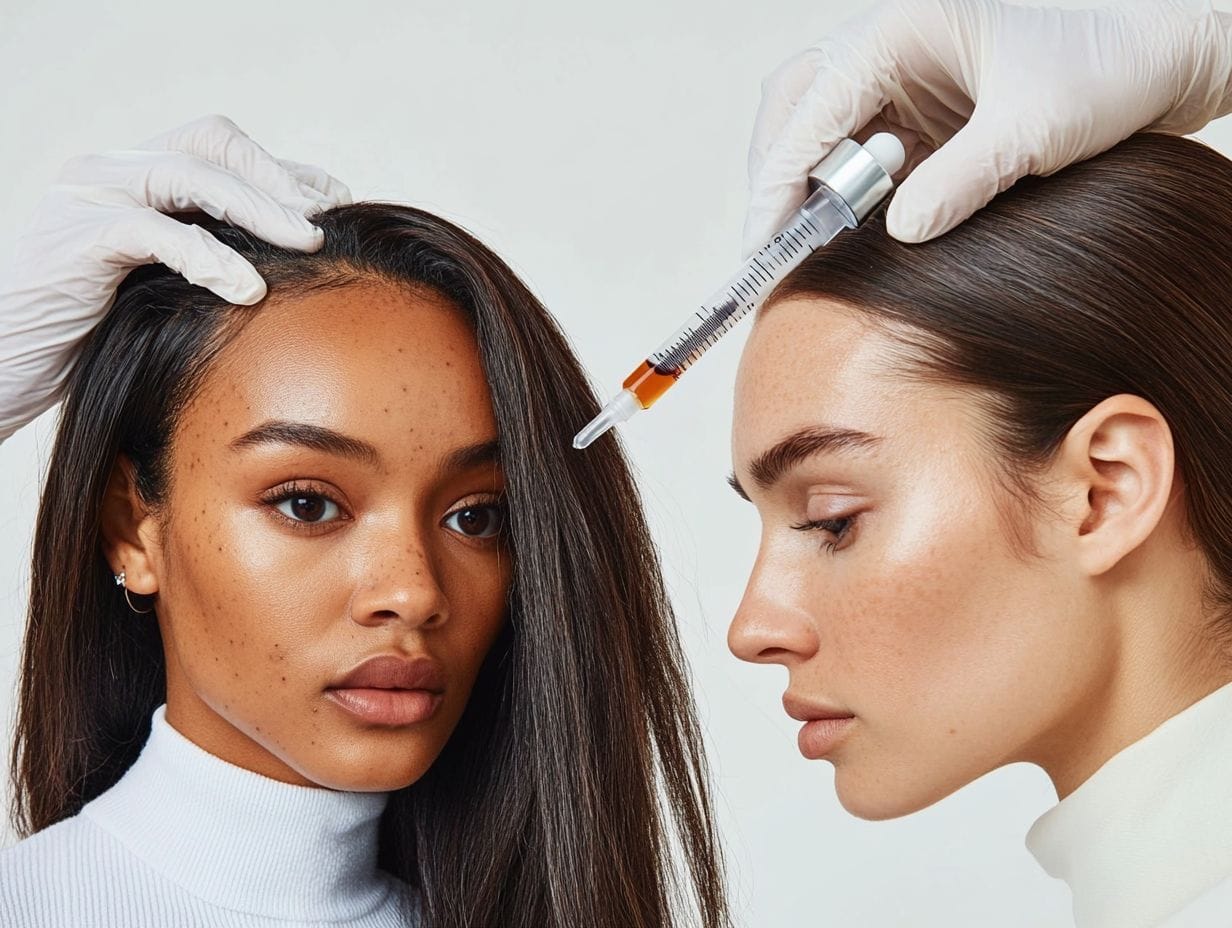Hair loss can be a distressing experience for women, impacting self-esteem and confidence. Understanding the common causes and types of hair loss is the first step toward finding effective solutions.
This article explores innovative treatments like microneedling and popular topical options, comparing their benefits and drawbacks.
Whether facing thinning hair or significant loss, this guide will help you consider the factors when choosing the best solution tailored to your needs.
Understanding Hair Loss in Women

Hair loss in women is a complex issue that can lead to significant emotional distress and challenges related to self-esteem. Various factors contribute to this condition, including hormonal imbalances and genetic predispositions such as androgenetic alopecia.
Understanding the underlying causes is critical for developing effective hair loss solutions tailored to individual needs. Additionally, societal pressures and lifestyle factors may exacerbate hair thinning, underscoring the importance of exploring treatment options that not only enhance scalp health but also promote overall well-being.
This guide aims to examine the common types and causes of hair loss in women, thereby facilitating informed decisions regarding future treatment options.
Common Causes and Types of Hair Loss
Common causes of hair loss in women include hormonal factors, genetic predispositions, and scalp conditions, each contributing uniquely to hair thinning and loss. The most prevalent type is androgenetic alopecia, which may present as diffuse thinning or localised bald patches.
Additional factors that may contribute to hair loss include stress, nutritional deficiencies, and certain medical conditions that impact scalp health. It is essential to identify the type and root cause of hair loss for effective management and treatment. By understanding these factors, women can explore targeted solutions that address their specific needs.
Awareness of various forms of hair loss, such as telogen effluvium and alopecia areata, can further clarify a woman's experience. Telogen effluvium, often triggered by temporary stressors such as illness or hormonal fluctuations, may result in noticeable shedding but is typically reversible. In contrast, alopecia areata, an autoimmune condition, affects hair follicles and can lead to unpredictable patches of hair loss.
Personalised care is crucial in navigating these challenges, enabling individuals to select treatment options that align with their unique conditions and hormonal influences, thus ensuring a comprehensive approach to restoring hair health and confidence.
Microneedling for Hair Loss
Microneedling has emerged as a prominent non-invasive treatment option for hair loss, utilising the body's inherent healing mechanisms to stimulate hair follicles and promote regrowth. This technique, referred to as collagen induction therapy, involves the creation of micro-injuries on the scalp, which facilitates improved blood circulation and nutrient absorption critical for follicle health.
Numerous dermatologists advocate for microneedling, particularly for individuals experiencing hair thinning or conditions such as androgenetic alopecia, as it has been shown to enhance the efficacy of topical solutions like minoxidil and PRP therapy.
It is crucial for individuals considering this innovative approach to comprehend both the benefits and potential side effects associated with the procedure.
How It Works and Potential Benefits
Microneedling is a procedure that employs fine needles to create controlled micro-injuries in the scalp, thereby triggering the body s natural healing response and promoting the rejuvenation of hair follicles. This technique not only improves blood circulation but also enhances the absorption of topical treatments, significantly increasing their efficacy.
The advantages of microneedling for hair restoration encompass increased hair density, improved scalp health, and the potential for long-lasting results when integrated with other therapeutic approaches. Numerous women have reported positive outcomes and noticeable enhancements in their hair care routines following this procedure.
This innovative technique has attracted attention not only for its immediate effects but also for its capacity to stimulate collagen production and activate growth factors essential for healthy hair. Clinical studies indicate that a significant percentage of patients experienced increased satisfaction, with many observing a marked reduction in hair thinning over time.
While some individuals have expressed concerns regarding safety, extensive research demonstrates that when microneedling is performed by qualified professionals, it is generally safe and associated with minimal side effects, such as slight redness or swelling that typically resolves rapidly.
Topical Treatments for Hair Loss

Topical treatments have become a fundamental component in the array of solutions for hair loss, offering accessible options for women experiencing hair thinning or loss. Among these treatments, minoxidil is notable for its clinically validated effectiveness in stimulating hair growth and promoting scalp health.
Additionally, other topical medications and serums frequently include natural ingredients and growth factors aimed at enhancing absorption and delivering essential nutrients to the hair follicles. It is imperative to assess various topical solutions based on individual requirements to ensure optimal results and maximise patient satisfaction.
Types of Topical Treatments and Their Effectiveness
Numerous types of topical treatments are available, each specifically formulated to address distinct hair loss concerns with varying levels of effectiveness. Minoxidil has been extensively studied and is frequently recommended due to its demonstrated ability to stimulate hair growth and enhance follicle health.
Other formulations may contain natural ingredients aimed at improving scalp conditions and promoting the absorption of nutrients essential for hair revitalisation. A thorough understanding of the differences in efficacy among these options can facilitate more informed choices in a hair care routine that is tailored to individual needs.
Certain topical treatments incorporate botanical extracts such as saw palmetto and rosemary oil, both of which have been shown to mitigate the effects of dihydrotestosterone (DHT), a hormone associated with hair thinning. These products often appeal to consumers who prefer a more natural approach to hair restoration.
The frequency of application is also a critical factor, as daily use typically yields optimal results, with consistency enhancing absorption and effectiveness.
By prioritising ingredient transparency and clinical validation, individuals can make informed decisions regarding which products are most likely to integrate seamlessly into their lifestyle while effectively addressing their specific hair loss challenges.
Comparing Microneedling and Topical Treatments
When evaluating the options between microneedling and topical treatments for hair loss, it is crucial to consider the distinct benefits and drawbacks associated with each method.
Microneedling presents a non-invasive approach that stimulates scalp health and improves the absorption of topical solutions, potentially leading to more rapid results. Conversely, topical treatments, such as minoxidil, offer the advantage of convenient at-home application and have a well-established history of clinical efficacy.
By thoroughly assessing the advantages and disadvantages of both methods, individuals can make informed decisions regarding their hair loss treatment options.
Pros and Cons of Each Method
The advantages and disadvantages of microneedling and topical treatments for hair loss present distinct considerations for individuals seeking effective solutions.
When evaluating these alternatives, it is essential to consider factors such as cost, treatment frequency, and overall patient satisfaction. Microneedling typically requires a series of sessions, which can result in significant cumulative expenses over time. In contrast, topical treatments may offer a more cost-effective option, coupled with the convenience of daily application.
Patients frequently report higher satisfaction levels with microneedling due to its observable results, particularly regarding its safety and effectiveness in promoting new hair growth. Conversely, the consistency of results obtained from topical treatments can vary significantly based on individual responses and adherence to the prescribed regimen, thereby complicating the decision-making process.
[second_cta_shortcode]Choosing the Right Hair Loss Solution for You

Selecting the appropriate hair loss solution necessitates a thorough evaluation of individual factors, including the underlying causes of hair thinning, personal preferences, and treatment objectives.
An initial consultation with a hair specialist or dermatologist can offer valuable insights into effective treatment options specifically tailored to one s unique scalp condition and hair care routine.
It is imperative to assess a range of therapies, including microneedling, topical treatments, and natural remedies, to identify the most suitable approach for achieving sustainable results.
A comprehensive understanding of these essential factors can enable women to make informed decisions regarding their hair restoration journey.
Factors to Consider and Consultation with a Professional
When selecting a hair loss solution, it is essential to consider several factors, including the individual s hair loss assessment, lifestyle choices, and treatment preferences. A consultation with a qualified professional can provide valuable insights into the most effective approaches, ranging from microneedling to topical therapies, tailored to the specific condition of the scalp and hair follicles.
Acknowledging the importance of personalised care can lead to improved treatment adherence and greater satisfaction with outcomes. By collaborating with hair specialists, women can navigate the diverse landscape of hair restoration options more effectively.
Such consultations extend beyond mere treatment selection; they also underscore the importance of ongoing education for patients regarding home care techniques and daily management. Understanding how to care for one s hair at home, in conjunction with professional guidance, can significantly impact the overall success of any chosen intervention.
Continuous assessment of progress enables timely adjustments to treatment plans, ensuring individuals remain on the most effective path towards regaining both their confidence and hair health. This holistic approach aligns with personal preferences, ultimately enhancing the likelihood of achieving the desired results.
Frequently Asked Questions
$
What is the difference between microneedling and topical treatments for hair loss in women?
Both microneedling and topical treatments can be effective solutions for hair loss in women, but they work in different ways. Microneedling involves using a small, handheld device to create tiny punctures in the scalp, which stimulates hair growth. Topical treatments, on the other hand, are applied directly to the scalp and work by nourishing the hair follicles and promoting hair growth.
What are the benefits of microneedling for hair loss in women?

Microneedling has been shown to improve hair density, thickness, and overall scalp health in women. It also has the added benefit of improving blood circulation to the scalp, which can further promote hair growth. Additionally, microneedling is a non-invasive procedure with minimal downtime, making it a convenient option for women with busy schedules.
Are there any potential side effects of microneedling for hair loss in women?
As with any cosmetic procedure, there is a risk of side effects with microneedling. These may include minor swelling or redness at the site of treatment, which typically subside within a few days. It is important to consult with a qualified professional and follow proper aftercare instructions to minimise any potential side effects.
What types of topical treatments are available for hair loss in women?
There are a variety of topical treatments available for hair loss in women, including shampoos, serums, and oils. These treatments may contain ingredients such as minoxidil, biotin, or essential oils, which have been shown to promote hair growth and improve scalp health. It is important to consult with a healthcare professional to determine the best treatment option for your specific needs.
Which hair loss solution is best for women with sensitive skin?
If you have sensitive skin, it is important to be cautious when considering microneedling or topical treatments for hair loss. Microneedling may cause irritation or discomfort for those with sensitive skin, while some topical treatments may contain ingredients that can cause allergic reactions. It is recommended to consult with a dermatologist to determine the best course of treatment for your individual needs.
Can microneedling and topical treatments be used together for hair loss in women?
Yes, microneedling and topical treatments can be used together for optimal results. Microneedling can help to increase the absorption of topical treatments, allowing for better penetration and effectiveness. However, it is important to consult with a professional to determine the proper timing and frequency of using these treatments together to avoid any potential adverse effects.


